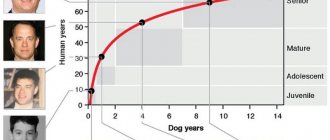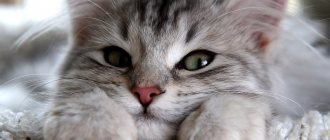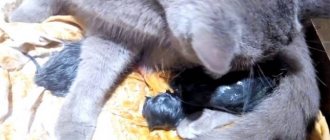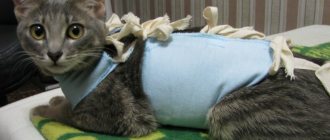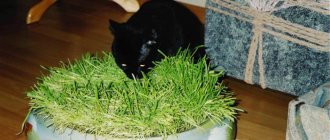Home » Useful Information
Many owners are interested in the question: how old is a cat by human standards?
As your pet ages, its behavior changes greatly.
From a small playful kitten, he turns into a calm cat, spending more time sleeping and less time on outdoor games.
Time passes faster for cats than for people.
To determine the age of your pet, you can refer to the correspondence table.
- 2 Option two - age ratio
- 3 Option three – elementary arithmetic
- 4 What to do if the pet’s age is unknown
- 5 Does breed affect life expectancy?
- 6 Does an animal’s lifestyle matter?
- 7 What the owner can do
The first option is calculation with a coefficient
To find out how old a cat is by human standards, a coefficient is often used.
This number determines the number of human years a cat lives in one year.
Each age group has its own characteristics
The calculations are based on social and emotional characteristics.
After all, comparing the logic of a person and a cat is not entirely correct.
The following is a table for this type of calculation.
Of course, this table contains only approximate data.
If the exact age of the cat is not known, a veterinarian will help determine it approximately.
At the same time, he will assess the health of the pet’s teeth and the condition of the body as a whole.
Important! It is extremely difficult to obtain reliable data on the level of intelligence in cats, therefore all methods of converting from age to human age are only approximate.
Although the coefficient gives a general idea of how old a cat is by human standards, it cannot be said that this is accurate data.
You should not think that at two years old the cat is fully formed intellectually and has adapted socially.
Such a table rather shows the aging of the body, its wear and tear.
Older cats are calm and measured
By the eyes
Eyes are not only the mirror of the soul, but also an important indicator of a pet’s age. How to find out the age of a cat at home using this criterion? It is enough to observe the behavior of the animal a little. Young cats have a lively gaze, quickly moving to an interesting object, and a little mischievous. At advanced age, these properties usually become dull.
It is worth paying attention to the structure of your pet's eyes. In a young animal, the glassy substance is smooth, without inclusions, and transparent. The iris is of even color and regular shape. In old cats, over time, the eye becomes cloudy and dull, and separation or destruction of the vitreous substance appears. The iris, which usually becomes deformed and thinner, has streaks and spots.
Important! Discharge from the eyes, clouding of the cornea, or spots on the iris may be a sign of an infectious disease or organ injury. At the first symptoms, contact your veterinarian.
Pets at a very advanced age develop wrinkles (folds) around the eyes. Discharge (watery or purulent) often forms from the lacrimal sacs.
Option two - age ratio
There is another way to convert a cat's age to human age.
Moreover, each year is equivalent to several years of people’s lives.
- The first year of life is counted as 15 human years.
- Second year - by 24.
- Each subsequent year adds 4 years to the age, this figure remains unchanged until the age of 16.
- After 16 years, each year lived is equal to 3.
With this calculation system, a two-year-old cat is perceived as a 24-year-old girl, and when she reaches 12 years old, as a 64-year-old lady.
Using this recalculation option, a number of analogies can be drawn.
For example, up to 1 year (like a person up to 15 years old), a cat learns to take care of itself, get along with its owner, and so on.
At the same time, the animal goes through puberty.
At two years old, the cat already has a formed character and knows how to demand from the owner what she needs (or simply wants).
Her behavior at this stage is really reminiscent of a young man or girl at the age of 24.
If we continue this calculation, by the age of 15 (which is 76 years in human terms), a cat, like an elderly person, may develop diseases.
And her behavior can change according to her age.
Age-specific features include the following:
- decreased interest in games;
- the appearance of behavioral characteristics characteristic of adults.
Breed affects age characteristics
Important! The appearance and nature of age-related changes depend on the breed of cat.
By weight
Be sure to pay attention to your pet's weight! Over the years, the animal’s daily routine changes, which is why the body weight of cats of different ages is different.
Kittens move a lot, their skeleton is not yet fully formed and strong, and the fat layer is almost not deposited. This is why babies and young pets weigh quite little.
Important! Monitor your pet's diet. A poor diet or lack of adequate exercise can lead to unhealthy weight gain!
Adults, and especially older pets, are already reluctant to agree to conquer the heights of a home closet or excitingly climb expensive curtains. They tend not to play as much and prefer to take more naps. A sedentary lifestyle leads to weight gain.
Option three - basic arithmetic
The simplest way to calculate how old a cat is by human standards is to multiply its age by 7.
In this case, each year of a furry pet’s life will be equivalent to 7 years of human life.
The result is not the most accurate.
A cat that has reached the age of one is much more independent than a 7-year-old child. After all, she is driven by instincts.
However, many more animals live to be 20 years old than people live to be 140.
These kittens are still very small
The main disadvantage of this method is that it does not allow one to compare the stages of development in humans and animals.
Therefore, this method is less preferable in calculations.
By behavior
It is possible to determine the age of a pet by its behavior. This method is quite subjective and depends on the character of the animal, but there are still common features in habits.
Baby kittens spend almost all their free time playing and communicating with each other and people. They are even ready to courageously sacrifice minutes of sleep for the sake of fun! Some kids even insistently demand attention to themselves.
Important! You should not be strict with your pet's behavior. Animals also have different types of personalities, so some cats are sociable, while others are shy.
Mature pets will enjoy spending time hunting and playing. However, they tend to be very sleepy.
Older cats no longer like unnecessary fuss, preferring quiet rest to noisy games. Pets can often be found dozing peacefully on a chair or on your bed. As cats age, their hearing often becomes dull and their vision begins to decline, which can cause the animal to become a little more fearful or nervous.
What to do if the pet's age is unknown
If a cat was picked up on the street, it will be difficult to determine how old it is at the moment.
However, age is important to know in order to find out how old a cat is by human standards.
Determining age can be entrusted to a veterinarian
To determine a cat's age, its teeth are examined.
Of course, it is better to have this done by a veterinarian.
Your furry friend is unlikely to enjoy oral examination.
If it is not possible to go to the doctor with this question, you should first study the progress of dental development.
- When a kitten is 1 month old, its baby teeth appear.
- At the age of 5-6 months they are replaced by permanent ones.
- Upon reaching 1.5 years of age, the central incisors of the lower jaw are worn away.
- Upon reaching 2.5 years of age, the middle incisors of the lower jaw wear off.
- At three and a half years of age, wear of the central incisors of the upper jaw occurs.
- At four and a half years of age, wear of the middle incisors of the upper jaw occurs.
- At the age of five, the fangs wear off.
- By the age of six, the outer incisors of the upper jaw begin to wear off.
- At the age of 7-8 years, modifications are observed in the rubbing surfaces of the central and middle incisors of the lower jaw.
- By the age of 9, wear of the central incisors of the upper jaw begins.
- At 10-12 years old, the central incisors may fall out.
- By the age of 15, all incisors may fall out.
Of course, these numbers vary depending on the animal’s lifestyle. diet plays a significant role .
If your cat's diet contains enough vitamins and minerals, the process of tooth wear and loss will noticeably slow down.
The condition of the teeth says a lot about the age of the cat.
By body processes
Perhaps determining age by the internal processes of the body is the most accurate way. Using this watch it is easy to find out how old your pet is.
Puberty in cats begins at 7-9 months (sometimes earlier, at 6 months), but in boys a little later - at 9-11 months. Slight differences may occur due to climate, breed and weight of the animal.
Determining the age of your pet is incredibly important. This is the only way to create the correct diet, daily routine and the amount of vitamins you need.
Does breed affect life expectancy?
Actually the answer to this question is yes. They can live much longer:
- mongrel cats;
- animals of natural or long-bred breeds.
Exotic cat breeds bred by humans live much shorter lives.
The reason lies in the fact that in order to preserve the characteristics of the breed (in the British , Maine Coons , Munchkins, Cornish Rex, exotics ), a small number of individuals are involved in breeding.
Cats that are not bred through selective breeding have much better developed immune systems and survival abilities.
Older cats need to rest more often
Does an animal's lifestyle matter?
For cats to live happily ever after, they need to be given the most favorable conditions possible. These include:
- proper, balanced nutrition;
- cozy, warm house ;
- no injuries;
- periodic visits to the veterinarian;
- protection from external adverse factors.
If you are interested in detailed information about proper grooming, we recommend that you read the article
In addition, the following factors affect life expectancy in cats:
- heredity;
- presence/absence of genetic diseases.
It is worth noting that sterilized cats and castrated cats have a longer life expectancy than individuals participating in procreation.
We recommend an article on the importance of sterilizing cats
The absence of stress during the mating season has a positive effect on their condition.
Neutered cats live longer
Interesting! According to the observations of veterinarians, the life expectancy in most cases in cats is from 10 to 15 years.
How long do domestic cats live?
The average life expectancy of a domestic cat is 15-16 years, provided that the pet is cared for, monitored and promptly shown to a veterinarian. When compared with stray cats, who live on average 5-7 years, domestic cats turn out to be real long-livers.
The lifespan of a pet depends both on genetics and on the care of the owner
The following conditions contribute to the longevity of a pet:
- Proper nutrition that meets the needs and health of the pet;
- Vaccination, which allows you to strengthen the cat’s body even in sterile home conditions;
- Physical activity, thanks to which the cat’s muscles do not become flabby and remain in good shape until old age;
- Routine examinations for the presence of fleas, ticks, roundworms, worms and other parasites that cause deep damage to the health of the animal;
- Sterilization, which protects cats from unwanted pregnancies in case they have access to the outdoors.
Playing with your pet allows him to compensate for his lack of movement in an apartment.
Influence of breed on lifespan
It is difficult to speak with certainty about a clear connection between breed and life expectancy. There are lists that allow you to correlate the breed and the approximate number of years to which its representative will live, but there is no need to talk about exact data. Among the long-livers are the following breeds:
- Australian Smoky Cat;
- Japanese Bobtail;
- Neva masquerade cat;
- Maine Coon;
- Siamese cat;
- American Shorthair;
- Manx.
Anomalies in the Manx body structure did not affect the number of years allotted to them
Among the cat breeds whose life expectancy is quite short are the following:
- Snowshoe;
- Bombay cat;
- Russian blue cat;
- Abyssinian cat;
- Ural rex.
The average lifespan of a Snowshoe is only 10 years
It is worth considering that life expectancy is influenced not only by the breed, but also by the genetics passed on to your pet by its descendants. If a cat is predisposed to a number of serious diseases, then even belonging to a long-lived breed will not save it from an earlier death. Conversely, representatives of the breed, which do not have much time allotted, can live much longer than the “norm” with proper care and good heredity.
Cat Rubble, who celebrated her thirtieth birthday, continues to live a fulfilling cat life
